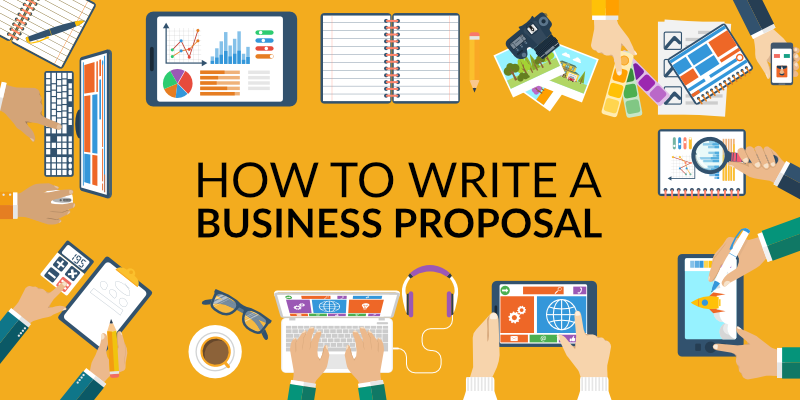
If you need to know how to write a business proposal, congratulations! You just found an amazing resource packed with business proposal examples and free templates to help you get started.
It’s totally normal to feel overwhelmed (and a little bit anxious) about writing a winning business proposal. You want to get it in as soon as possible, but you have no idea what to put in there, how long it should be, or even where to start.
However, should the task still seem insurmountable, or if you find yourself strapped for time, remember that there are professional services available that can assist. An option some businesses consider is to pay for research paper expertise, especially when their proposal requires substantial market analysis, competitive research, or financial forecasting. Engaging with professionals who can compile comprehensive, data-backed business proposals can not only elevate the quality of your submission but also significantly reduce the stress associated with such critical tasks.
Writing a business proposal doesn’t need to be daunting. In fact, if you soak up all of the information in this article, you’ll already be one step ahead of the competition. So relax, pour yourself a coffee, and let’s make your next business proposal easier to write.
Table of Contents
- 1 What is a business proposal?
- 2 Solicited and unsolicited proposals
- 3 What does a business proposal include?
- 4 What’s the difference between a business proposal and a business plan?
- 5 How to write a business proposal in 6 steps
- 6 Business proposal templates
- 6.1 Proposify
- 6.2 Free template number 1
- 6.3 Free template number 2
- 6.4 Free template number 3
- 6.5 Free template number 4
- 6.6 Free template number 5
- 6.7 Qwilr
- 6.8 Free template number 6
- 6.9 Free template number 7
- 6.10 Free template number 8
- 6.11 Free template number 9
- 6.12 Free template number 10
- 6.13 PandaDoc
- 6.14 Free template number 11
- 6.15 Free template number 12
- 6.16 Free template number 13
- 6.17 Free template number 14
- 6.18 Free template number 15
- 6.19 Decktopus
- 7 Let’s wrap this up
What is a business proposal?

A business proposal is a document that’s used to secure work. It can be sent by an individual or a business and is usually (but not always) a proposed solution to a specific job, project, or service that’s required.
Business proposals are also sometimes used by suppliers to secure business.
Think of a business proposal as a bit like a sales pitch, or a job interview on paper. You need to explain why you’re the best person (or company) for the job and really sell yourself or your business. Search online for business plan presentation templates to help you present your business proposal ideas to people and companies.
A good proposal will outline the service you’re offering and briefly explain how you will approach the task. It will also include a quote and/or an estimate to complete the work.
Solicited and unsolicited proposals
A business proposal can be solicited or unsolicited. If a business proposal is solicited, it means that the individual or business writing the proposal has been asked to submit a proposal by the prospective client.
RFP’s (request for proposal) is the standard way that businesses ask for submissions.
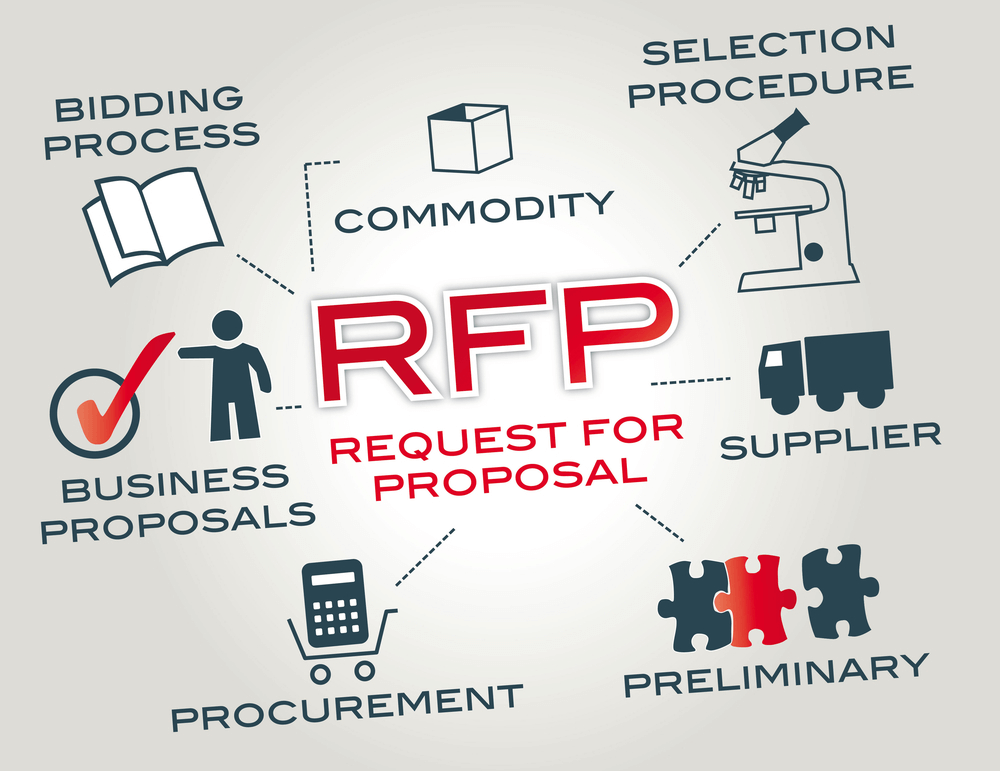
Any business or individual can send out an RFP, and there are lots of templates available online to help you do this.
To give you an example, let’s say that a company (not yours!) was being sued. The company’s legal team might then send requests for proposals out to various law firms. The RFP would most likely contain an explanation of the situation and ask for help and legal advice.
Solicited proposals are generally easier to write because you are given clear guidelines. With a solicited proposal, you know exactly what the client or customer wants and can tailor your response accordingly.
Make sure you read the RFP thoroughly. Not only will this help you to deliver a comprehensive and relevant business proposal, but the RFP will often contain useful information about the criteria being used to make the final decision.
If you’re asked to submit a business proposal, you may also be given instructions for formatting, so be sure to check those too before you submit.
If you’re trying to attract clients by sending out business proposals without first being asked, then your proposal is unsolicited. Like cold-calling, these proposals are commonly used to try to generate leads.
Unsolicited proposals can be a little more difficult to write because you don’t have any information to go on. An unsolicited proposal also needs to be far more persuasive, which means it’s up to you to do your research on whoever you’re targeting and demonstrate your value proposition.
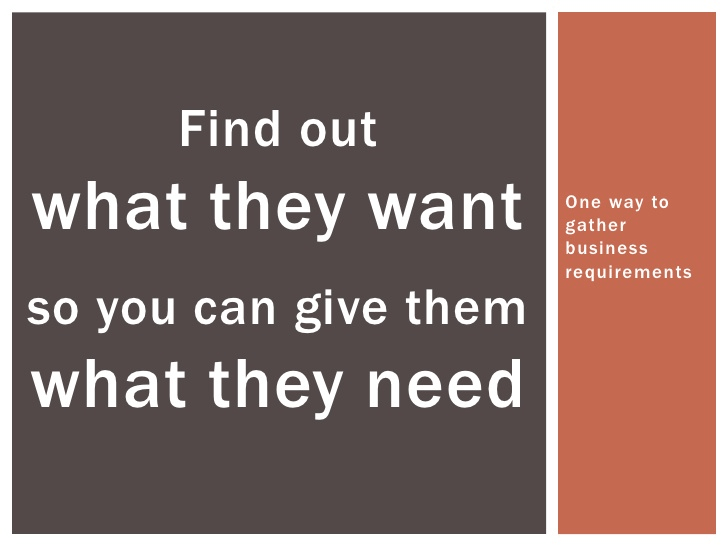
Unsolicited business proposals should serve as an introduction to your product or service and aim to convince your prospective client that they should be using your service.
An unsolicited business proposal differs from other advertising materials in that it carefully considers the customer’s needs and concerns and addresses them specifically.
Obviously, a solicited proposal is far more likely to win new business as the company already has you on their radar. Unsolicited proposals do have their benefits though, the most obvious one being that there is no competition.
Sending out unsolicited proposals, providing they’re well researched and offer creative solutions to your client’s problems, can be an extremely effective marketing campaign.
Some companies, particularly government agencies, actively encourage the submission of unsolicited business proposals.
If this is the case, they will likely have a review schedule and/or submission guidelines. So it might be worth checking those out and timing your proposal submissions accordingly.
What does a business proposal include?
So, what the heck should you put in your business proposal?
Well, we’re going to deep dive into detail further down, but for now, here’s the basic format to give you a better idea of the key elements that should be included in all business proposals, whether they’re solicited or not:
- Title or cover page.
- Table of contents (optional but useful for longer proposals).
- Executive summary
- Acknowledgement of the problem.
- Proposed solution / Outline of approach.
- Deliverables.
- Timeline.
- Pricing.
- Company information.
- Case studies and/or testimonials (optional but recommended).
- Terms and conditions.
- CTA / how to proceed.
Here’s a great video that talks you through what goes into a winning business proposal:

What’s the difference between a business proposal and a business plan?

People often get confused between these two documents, but they’re actually very different.
Proposals and plans differ greatly in both their purpose and their audience.
A business plan is all about you. It’s a document that provides details about your company’s strategy and demonstrates how you intend to grow. The intended reader of this document could be an investor or a bank manager, for example.
The idea of a business plan is to outline your goals, show that you know what you’re doing and that you’re worthy of investment. Therefore, in this document you might discuss how you intend to scale and how you will make and increase profits.
A business proposal is all about them. A business proposal is a document designed to sell your services to someone else.
While you can certainly use some of the information in your business plan to help you write a business proposal, the focus for your proposal should not be on you, but on whoever it is you’re trying to bag as a client.
A business proposal should therefore focus on how you intend to meet the potential client’s problem, how you can help them out or provide value to their business. Paper writing help is essential for crafting compelling business proposals. These proposals should center around addressing the potential client’s specific challenges and demonstrating how your services can effectively solve their problems.
Another way to look at it, is that a business proposal is selling your services to clients and a business plan is selling your business to investors.
How to write a business proposal in 6 steps
Step 1 – Make sure you have all the information you need
The first thing you need to do is gather all of the information you need. Actually, scratch that. The very first thing you need to do is take a deep breath and relax.
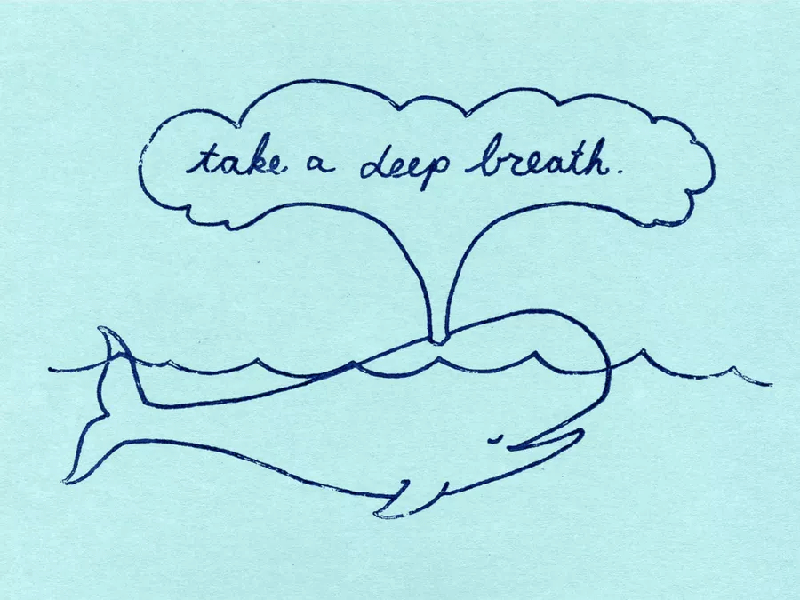
Now that you’re nice and calm, let’s dive in. First things first. You’re going to be tempted to fly through the process for fear of missing out on the job. Don’t give in to the urge to panic and rush the business proposal!
While you certainly do want to submit your proposal as soon as possible, it’s far more important to do a good job on it.
You don’t want to spend your precious time putting together a business proposal only to realise that you’ve forgotten a crucial detail. So, be methodical and take your time.
Useful questions to ask before writing your business proposal:
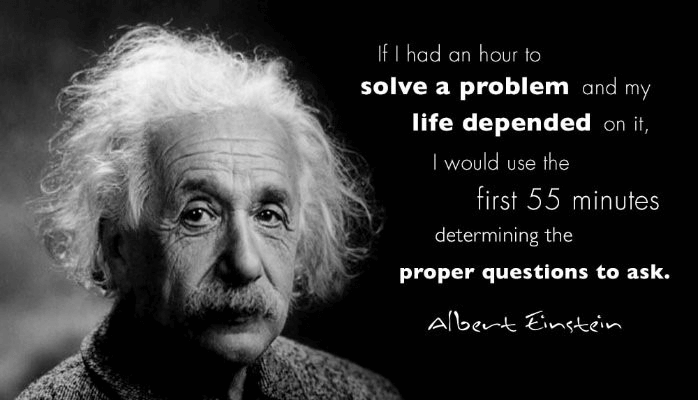
Now, what information do you need to write this entire proposal? Here’s a list of questions to ask yourself before you begin writing:
- Have I spoken to the client? – Talking to the client helps you to build up a repore and get a really good grip on what they’re after.
- Do I fully understand the requirements? – Your client is a mine of information. Make sure you’ve gone through everything with them and thoroughly check any documentation you’ve been given. If you have a request for a business proposal, make sure you go over it carefully so that you understand exactly what your client wants.
- Can I deliver what they’re asking for? You need to make sure that you have a clear understanding of the problem / pain points and that you have a custom solution to offer.
- Is this the first attempt to solve this issue? – You don’t want to suggest something that’s already been tried. Looking at prior attempts and why they failed can provide a useful framework that could help you provide a better solution.
- Do I have any questions? – What further information do you need to submit an accurate and successful business proposal?
- Do I need to do some research? – Thorough research makes a great impression. Don’t be afraid to approach your potential clients’ staff, as well as researching your competitors to see if you can offer something that will make your business proposal stand out.
- Who will be reading the proposal? – Is it just one person, or will it be passed through a team? Knowing who you’re talking to will help you tailor your business proposal to your audience and increase your chances.
- Who is the final decision maker? Knowing who makes the final decision (and what boxes they need to check) can give you a great advantage.
- What are the budget and project timeline expectations? – When does the prospective client expect you to start and finish the project? How much are they willing to spend? If you can’t meet the clients budget or deadline then don’t submit a proposal.
Top tip: Customer Relationship Management
If you’re sending out multiple business proposals, you could probably benefit from using CRM (customer relationship management) software.
Basically what this does is allows you to keep track of all of your contacts, appointments and leads. It’s a useful tool for creating a comprehensive system to organise your proposals and your contact with clients.
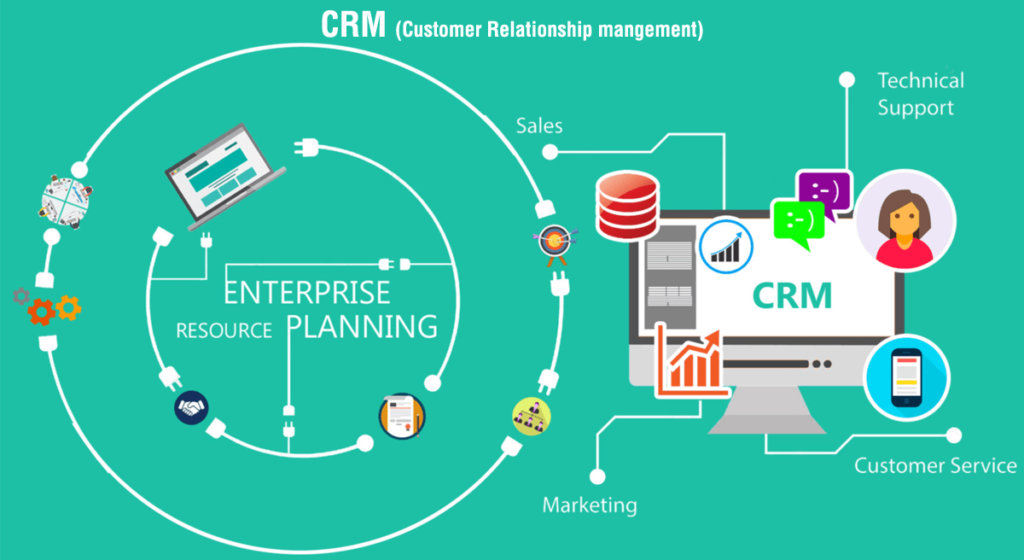
There are tons of CRM providers out there. So, to save you some time, here are the top 5 CRM options (I highly recommend option 1 if you’re just getting started):
- Hubspot CRM– One of the top CRM services on the market, and it won’t ever cost you a penny! This free platform offers powerful tools that work for any industry or niche. It’s simple, quick, and easy to get started. Check out all the awesome features and benefits.
- Salesforce CRM – This software app lets you track all of your interactions under one umbrella. It is fully comprehensive, offers extensive sales and marketing solutions and is suitable for everyone from beginner to behemoth. Prices range from $25 to $300 per month.
- Freshsales – Freshsales is a global company with a fantastic reputation. Their CRM does a great job of combining organisation with analytics. The interface is simple to navigate, and the software allows you to easily keep track of, score, distribute and nurture thousands of sales leads. They do have a free forever option (Sprout), otherwise prices range from $12 to $79 a month
- Pipedrive. This fully mobile optimised system is praised for its co-operative capacity. It syncs well with Google Calendar, Google contracts and other Google apps. Pipedrive is a popular choice because it can also accommodate most third-party business apps. No freebies here I’m afraid (just a free trial). Prices range from $15 to $59 per month.
- bpm’online. Last but not least, this software is designed to help you streamline and boost productivity. The aim is to bridge the gap between marketing, sales and customer service. They offer 7 different packages ranging from $25 to $50 a month.
Step 2 – Sketch out the scope of the project
Once you have gathered all of the relevant information to write the business proposal, you should have everything you need to outline the scope of the project.
The scope of a project refers to the amount of work that needs to be completed to satisfy the clients requirements. Here’s a useful video that explains the concept (and the dreaded scope creep!):

To complete your scope outline, you need to develop a thorough understanding of what the work is going to involve. You should note down the various tasks to be completed along with any resources you’ll need.
At this point you should also assess how long the project is likely to take and begin taking costs into account.
Try not to get too bogged down with details at first. It’s better to treat it as a rough draft and then once you have your outline, you can flesh it out by filling in all of the details later. This is where a project plan template can help you outline your project in a structured way.
Here are some useful questions to help you create your outline:
The whos:
Who will carry out the work?
Who will ensure the quality of the work?
Who will be the client’s point of contact?
The whats
What needs to be done?
What materials will you need?
What other resources will be required?
What resources do they already have?
What does the customer expect?
What will it cost?
The hows
How long will it take?
How will you approach the task?
How will you divide the work?
How will you ensure the client is happy?
How will you communicate?
How can you sell your solution?
The wheres
Where will you be working?
Where will you get your materials?
The whys
Why have you chosen your particular solution?
Why should they hire you?
The whens
When can you start?
When will you meet your milestones?
When will you finish?
When will you expect payment?
Step 3 – Estimate the cost

Ok, so you’ve gathered all the information and you have successfully measured the scope of the project. Well done you! Now it’s time to start pricing up the job.
The best way to do this is to first figure out how much it’s going to cost you to do all of the work.
Make sure you include labour and material / equipment costs as well as things like transport. Try to be as accurate as possible and don’t forget to factor in any discounts for bulk buying etc.
You should already have a good idea of how long the job is going to take you, so factor in your labour costs accordingly.
A good rule of thumb is to multiply your estimated labour time by 1.5. This way you allow for any unexpected twists and turns in the project.
You can always make your client really happy by knocking these extra hours off the bill at the end of the project if they weren’t needed!
If the amount of time spent on a job iIs likely to vary (a construction worker may not know the full extent of a job until work has begun for example) then make sure that you include a caveat in your proposal that covers you for this.
Continuing with the construction worker example, these workers will also have to account for things like scope creep. If a construction worker hires a painter, they have to ensure that the client doesn’t ask for a paint job in a part of a house they didn’t agree to.
These painters could then use a helpful estimate app for painters to state a clause that prevents a constant influx of duties or costs.
Once you have all of your costing done it’s time to decide on your profit margin. This will vary depending on the type of business you are in. So, it’s probably best to do some research and check the industry standard.
With this information, you can start filling out an estimate template if you’re already charging your client for services.
Step 4 – Start writing your business proposal
You’ve done all the research, you’re prepared. Now it’s time to start writing. Gulp.
We’re going to break it down into the basic structure and take it step by step, starting with the cover.
Cover / title page
An attractive business proposal template makes your document more attractive.
Design matters. Given the option, 66% of people prefer to read something that’s well-designed instead of plain.
Even if your proposal is well written, offers a cost-effective creative solution and adds a ton of value, if your cover page looks like this:
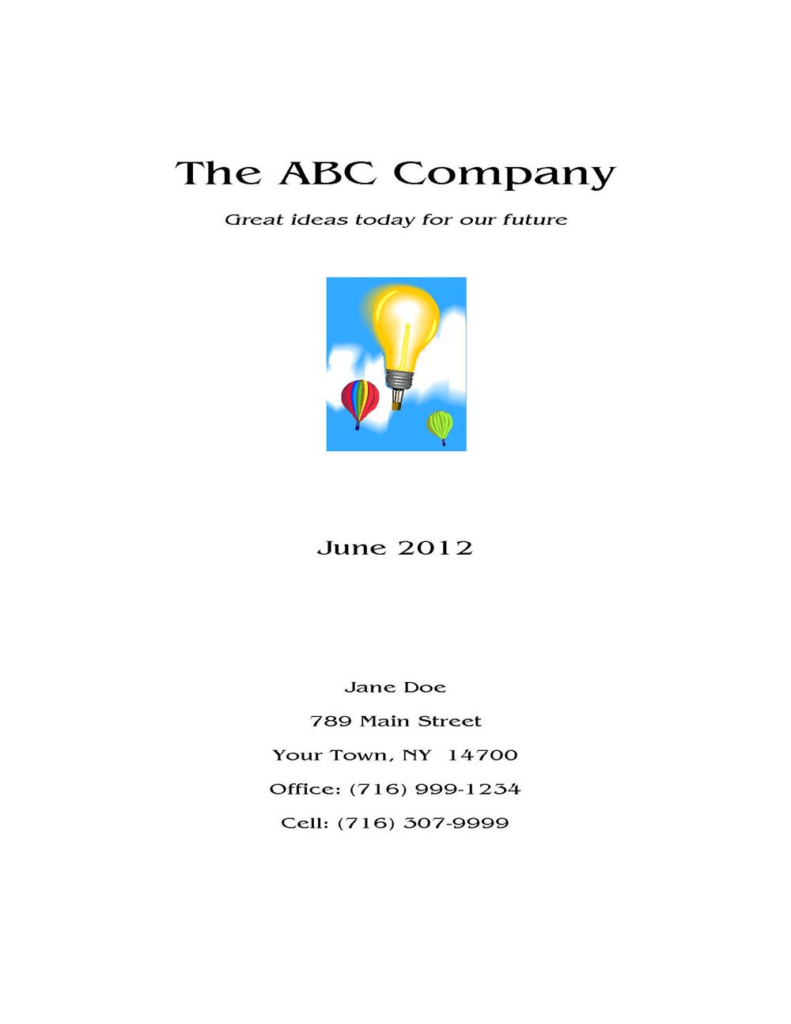
It’s going to put people off.
You might think that design isn’t that important for a business proposal. All that really matters is the cost, right?.
Wrong!
We live in a highly visual world where design influences our decisions all the time.
For example, did you know that most people (96% to be exact) equate design with how trustworthy a businesses is?
Like it or not, looks matter and you will be judged on them. A great design speaks volumes about your business and if done correctly, interactive proposals can make a fantastic impression.
Design isn’t just about the visuals. It also extends to the layout of your document.
Poorly formatted proposals can be unappealing, confusing or hard to read. For an attractive proposal, you want to make sure that the document has a nice look and an appealing easy-to-digest layout:

Consider the alignment, spacing and the text sizes you’re using. The goal is to clearly present your ideas and make it easy to read.
As a general rule, you want to break up your text as much as possible. So, use plenty of headings, bullet point or numbered lists and images or graphs where appropriate.
Short paragraphs and sentences work better because they are easier to scan.
You don’t need to do anything fancy. In fact, simple designs usually work better for business proposals.
If you have a designer on your team or an eye for design yourself, then it’s well worth putting in the effort to create an enticing cover design for your next business proposal.
There are lots of companies that help you do this, such as Canva, Adobe spark, and Poster my Wall to name but a few.
Not creative? Not to worry.
For those of you without creative bones, there are hundreds of free templates available for you to make your own.
Check out this eyecatcher from proposify which is 100% customisable:
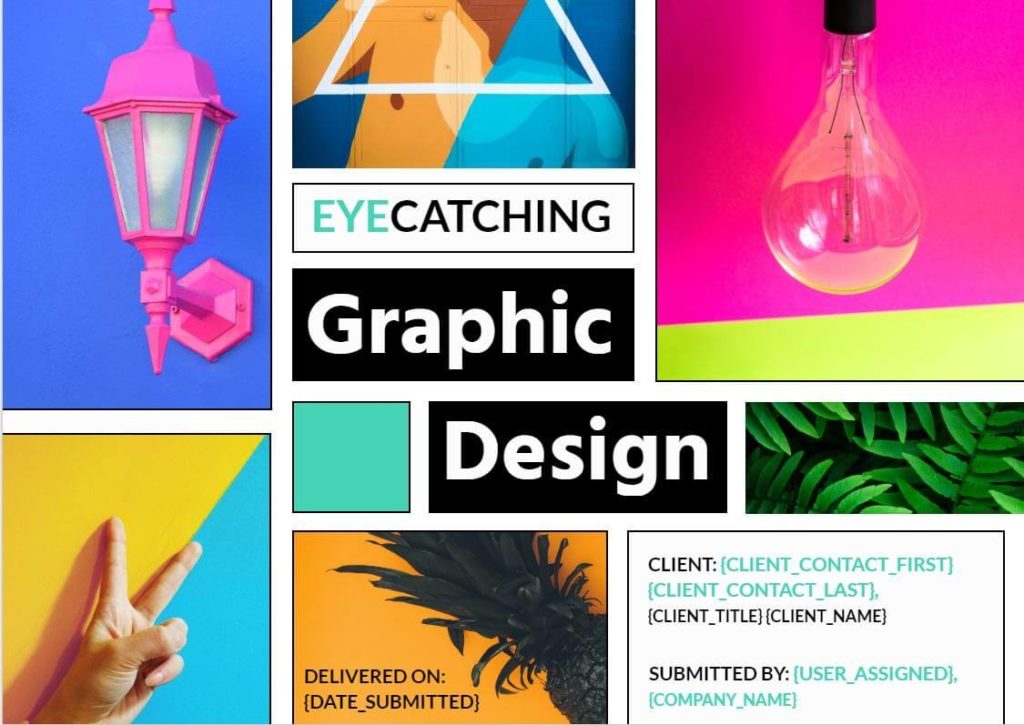
You can see that there is space (on the bottom right) for some information to be put on there.
So, what is the most important information you should include on your title / cover page?
-
- A snappy title page – putting “a proposal submitted to ABC for the purpose of XYZ” is a wasted opportunity. Remember that the goal here is to sell yourself, so think like a marketer and create some compelling copy.
- Your company logo
- Your name and contact information.
- Your client’s name.
- The name of the person you’re submitting the proposal to.
- The date of submission.
- Any useful reference numbers. – For adding name and contact number, consider sharing a digital business card with your details for a professional look. You can check online resource like this to find the best digital card software
A word to the wise. If you’re using your own (or your client’s) logo on your title page, then make sure it’s a high resolution image.
There’s nothing worse than a grainy, insipid, poor quality image on the front of a proposal!
Introduction or cover letter
Whether you include your introduction in the main body of your report or send it separately as a covering letter is up to you.
In either case, you’ll want to keep this section fairly short. 1 or 2 paragraphs is fine:
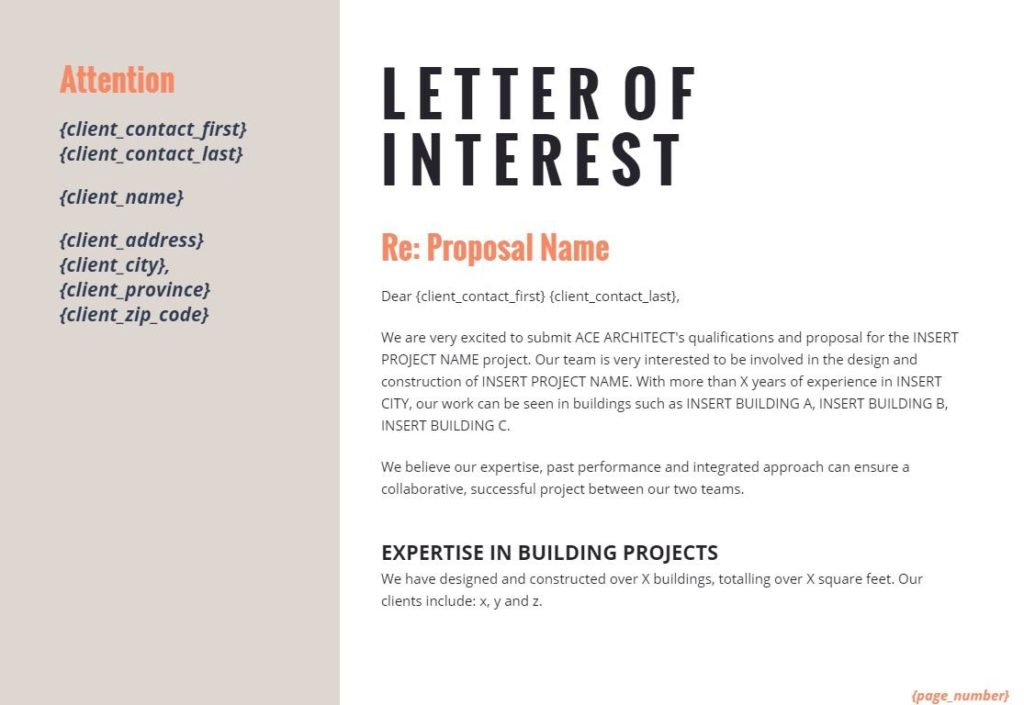
Proposify – Architecture proposal template
Introduce yourself and your company in a couple of sentences. You may want to explain your background briefly.
Highlight your strengths and make it clear why you stand out. The tone should be friendly.
It helps if you can keep your clients needs in mind while you’re writing and present your strengths in a way that makes it clear how they can benefit from working with you.
Here’s an example of an effective cover letter:
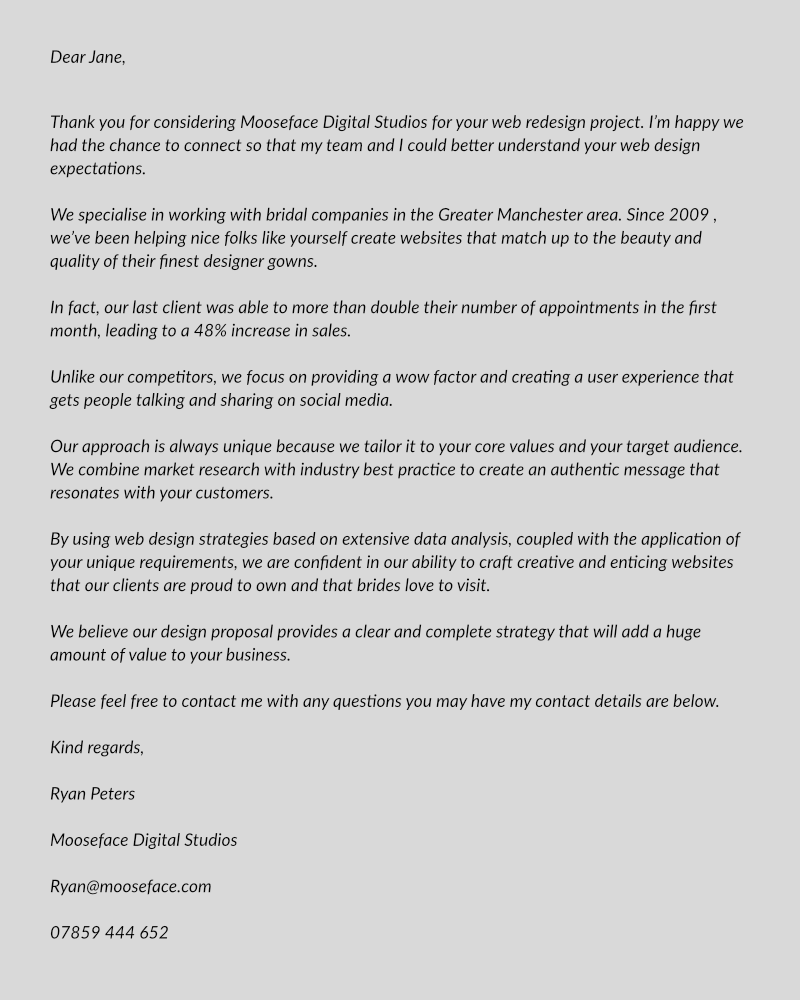
Executive Summary
Most people believe that this is where you present the project in a nutshell. Which is sort of right, but not quite.
You see, it’s more about selling than summarising.
While you do want to summarise your proposal, the main goal of the executive summary is not to provide a basic overview of the whole project, but rather to highlight why your proposed solution is the right one.
A good executive summary needs to be persuasive and benefit focussed. This is your opportunity to sell your solution to the client’s problem!
Focus on persuasion over description, use clear and straightforward language to make your points, and try to keep it short, less than 1 page is a good length.
This might be the first page your prospect ever reads, so make it count! Remember, you’ll have plenty of time to go into more detail later.
Start with something that grabs their attention and makes them want to keep reading.
Next, show that you have a clear understanding of the problem. Once you’ve done that, then you can show off your custom solution. Don’t forget to stress the benefits!
Figuring out how much detail to include here is tricky. You want to put some detail in there to back up what you’re saying, but not so much that it becomes a dull read.
It’s a balancing act and you’ll need to use your own judgement.
It’s a good idea to pop in a bit of social proof, and then round things off with a call to action.
Table of contents (optional)
Depending on how long your business proposal is, you may want to include a table of contents.
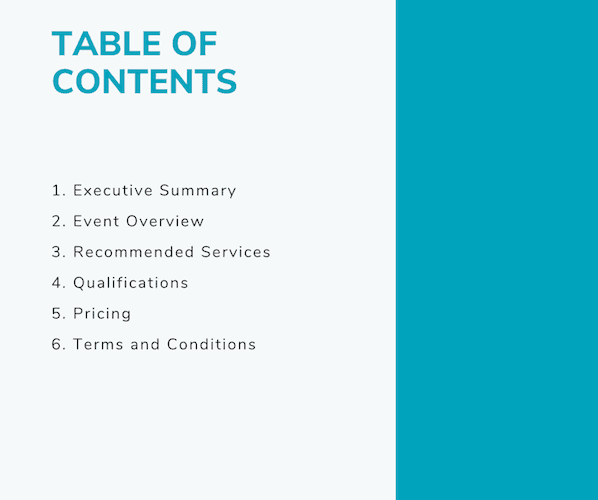
A table (showing the page number where each section can be found) will help the reader navigate your proposal more easily.
If your proposal includes industry-specific terms, you may also want to include a table that explains these.
The main body
This section will make up the majority of your proposal.
There’s a lot of information that needs to be included, so let’s break it down into smaller sub-sections that are easier to manage.
Approach / solution
Here’s where you delve into detail about your client’s problem and your solution to it.
You need to go through your entire process, detailing exactly how you intend to approach the problem and what results the client can expect.
You will need to demonstrate that you are aware of any potential challenges and ensure that your solution is customised to your potential client as much as possible.
It can be tempting, when you’re sending out lots of proposals, to just use the same one across the board.
But changing a few details, making the proposal feel more tailored, adds a personal touch that goes a long way to improving your results.

Deliverables
What exactly do you intend to deliver?
It’s important to have an itemised list of everything that’s included in the price and a detailed description for each item on your list.
You may also want to split your deliverables along a timeline as in the following example:
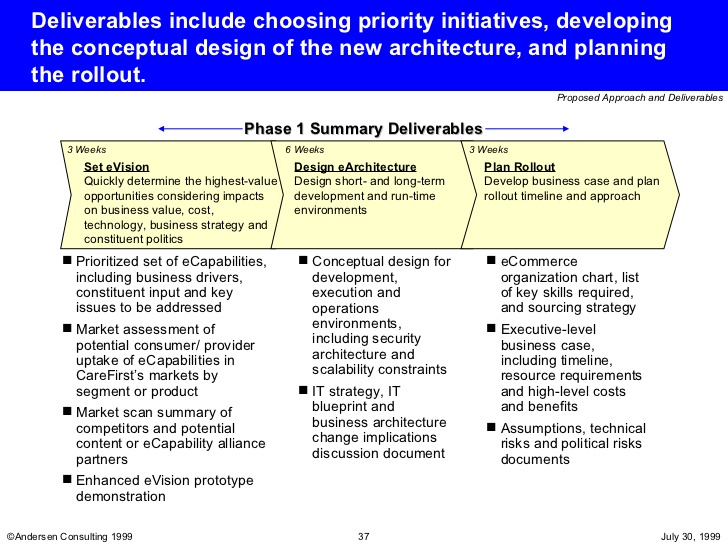
Project milestones
It’s a good idea to break down the project into several phases. This gives the client a good idea of how the project is likely to progress.
Outline the key events and deliverables involved with each stage. Give a realistic time frame for each part of the project, and say who is responsible for each deliverable.
Budget & pricing
If you want to win clients and maintain good profit margins, you’ll need to price your jobs up accurately.
It’s a good idea to have an itemized table that clearly shows all of your costs.
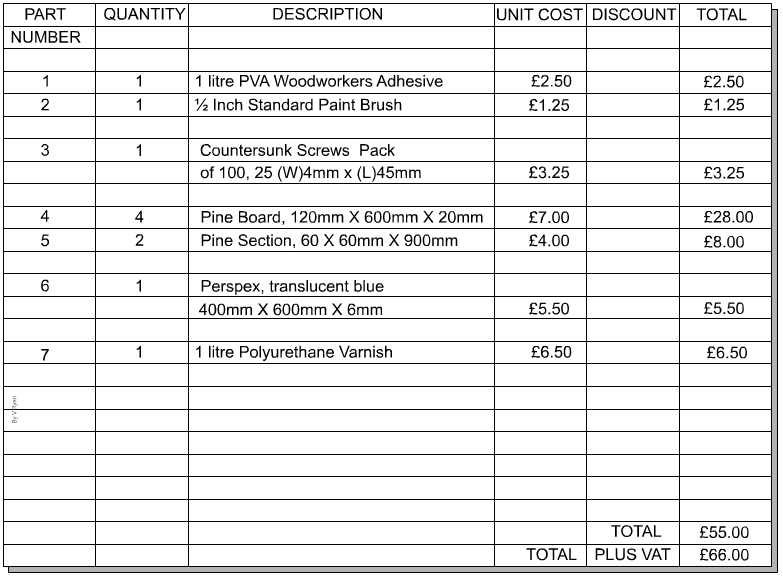
The more specific and clear you can be about your pricing the better. A table like this is also a useful tool for negotiations later down the line.
About us
This is where you really sell your company. Top tip – think like a storyteller and make it interesting.
If you have an about page on your website, you might want to use this as a resource. And if you don’t, it’s well worth checking out some of the best about us pages on the internet for inspiration.
Explain who you are and what your company is all about. Talk about your values, your team, (include bios and photos to sell your team’s expertise) and your journey.
Highlight your expertise and your USP.
If you have awards, social proof, testimonials or case studies feel free to put those in as well. Check online for AI based templates to help you with the right format.
This section is all about familiarising the client with your business. You want your reader to feel like they know you and your company well.
Clients and references
This section is optional. However, including contact information for one or two past clients (make sure you ok it with them first) shows that you’re confident and can help to build trust.
If you have a bunch of particularly impressive success stories, you may want to include a slightly longer client list.
Terms & conditions / moving forward
The final section for your main body should first include your terms and conditions and then provide information / steps and a call to action for moving forward.
Your call to action might be an invitation to visit your website for example.
This section serves as a conclusion to the main body. Basically, you want to briefly reiterate how you can help, and go over what you and the client are both promising by agreeing to the business proposal.
Specify the duration of the agreement, the timescale for completion, and payment types and dates.
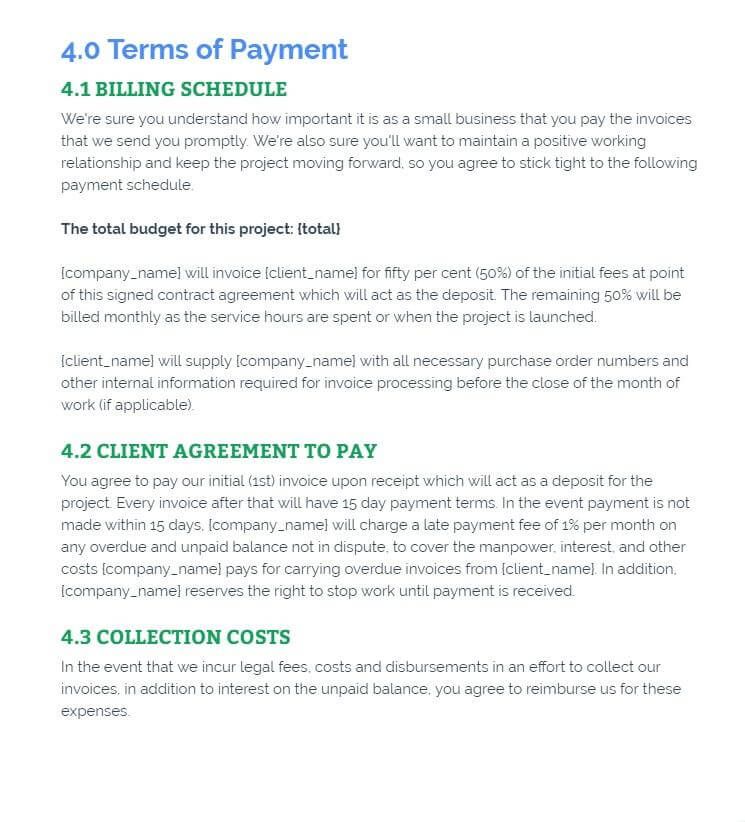
Proposify’s AdWords and PPC proposal template.
You’ll also want to include any caveats or disclaimers in this section.
Your disclaimers should make your potential client aware that the pricing is for the work stated in the proposal and that you reserve the right to charge more should any unforeseen circumstances arise.
Step 5 – edit and proofread
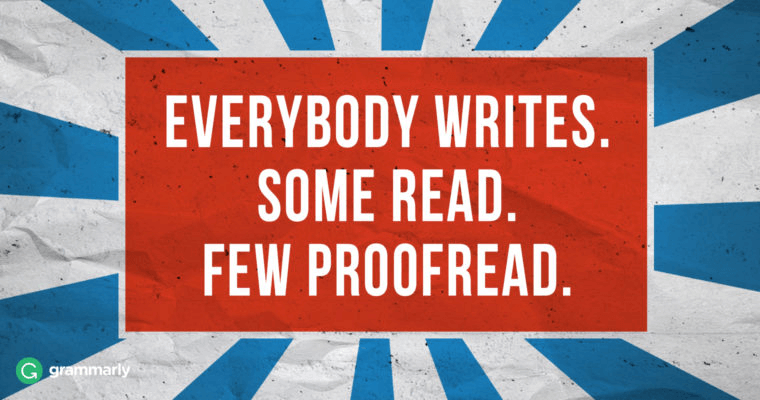
Once you’re done writing the proposal, you’ll want to go over it and check for any mistakes.
If possible, it’s best to get a fresh pair of eyes on it (or 2).
It’s also a good idea to run it through Grammarly or a similar program – just don’t rely on it completely as it will only pick up on basic spelling and grammar mistakes and not misused or unintended words.
A good test to check if your offer is well explained is to give the proposal to someone who doesn’t work in your industry and ask them if it’s clear what you’re offering.
If you want to be certain that your business proposal is mistake free, consider hiring a freelance proofreader / editor (with experience of dealing with business proposals) to check through it for you and provide some feedback.
Business proposal length
How long is a piece of string? Unfortunately, there’s no ideal length for a business proposal.
Some companies give out guidelines, but the length can still vary greatly depending on the industry and also on the depth and scope of the project.
Unsolicited proposals will generally be shorter than solicited – potential clients that have asked for a proposal are much more likely to sit down and read a longer document.
As a general rule, you want to keep it as short and succinct as possible, while still providing all of the necessary information and detail.
Your language should be clear and concise. It’s a good idea to use plain English and refrain from industry jargon and technical terms.
If you must use technical terms, then break them down to ensure that your reader understands them.
The easier your proposal is to understand, the easier it will be for the buyer to say yes!
How to keep your business proposal short and punchy
When it comes to proposal writing, a good tip to keep the length under control is to use economical sentences.
That means that your sentences should not contain any unnecessary words.
I’ll show you what I mean. Here’s an example of a sentence that is far too long winded and confusing:
For the purposes of adhering to the current regulations, I intend to take each and every precaution necessary in order to adequately fulfill the health and safety requirements.
If we get rid of all the unnecessary words and simplify the sentence, it now reads much more clearly:
Every precaution will be taken in line with health and safety regulations.
Here’s another example of a sentence that contains a lot of unnecessary words:
It’s important to plan ahead in order to avoid unexpected surprises and unintentional mistakes.
There are three words in the above sentence that don’t need to be there:
It’s important to plan ahead in order to avoid unexpected surprises and unintentional mistakes.
Ahead isn’t needed because planning always involves thinking ahead.
All surprises are unexpected, so that word doesn’t need to be there either.
It’s rare that someone makes a mistake on purpose so the word unintentional doesn’t belong.
If we take out the unnecessary words the sentence still makes complete sense:
It’s important to plan in order to avoid surprises and mistakes.
Why use “for the purpose of” when “for” will do? Why use “in the event of” when “if” is all you really need?
Check your proposal for unnecessary words and get rid of all the junk words from your sentences. Your proposal will be much more appealing and far better understood.
Also, avoid unnecessary repetition of words and phrases.
Another trick for proposal writing is to take out any tables and graphs and put them into an appendix at the end. Be sure to reference them in the main body of your text so that they are easy to find.
If you’re using examples to make a point, try to limit them to one or two. It’s easy to get carried away when you’re passionate about the results that you can deliver. So make your point (well) and move on.
Use appropriate language and tone
Have you noticed how many companies are dropping the formalities these days?
Contrary to popular belief, you don’t need to adopt a stuffy and formal tone in your business proposal!
You want to be professional, of course.
But there’s nothing wrong with adding a bit of personality.
A friendly conversational style can make you more relatable and work wonders when it comes to winning bids.
Don’t be afraid to have fun, notice the language in the example below is both professional yet informal and playful:
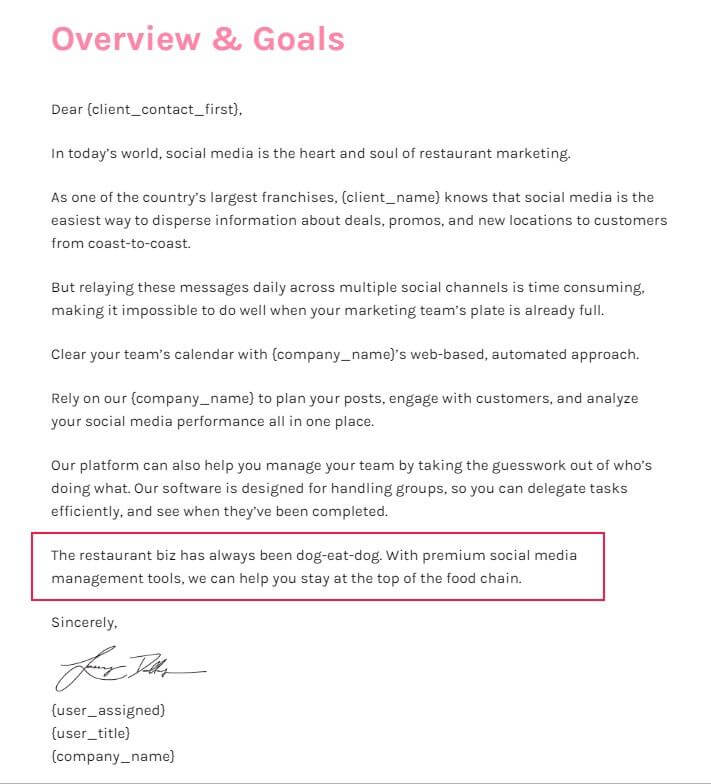
Proposify’s SAAS proposal template.
Obviously, your choice of tone is going to be greatly influenced by the business you’re in.
Have a look at your company’s website. Have a read of their promotional materials. What sort of tone do they adopt?
Think about your target audience, and try to mimic the type of language they use. If you can, try to customise your tone for your reader, while also staying true to your brand.
Step 6 – send your proposal (and follow it up!).
How to submit your proposal
Most of the time you’ll probably be sending your business proposals as an email attachment.
However, some businesses have a preferred submission process, so you should check whether that’s the case before you hit send.
If you have an RFP make sure you check it for instructions on how to submit.
It’s important to follow the directions exactly so that you don’t start off on the wrong foot.
You may be asked to log into a company’s portal or submit an application form that accompanies the proposal. Some companies may also ask for hard copies.
Some companies may even use submission guidelines as a test of your diligence.
For example, let’s say that the company you’re submitting to asks for the proposal to be formatted with double line spacing.
Any companies that miss this simple instruction will stand out a mile (and appear lax) and their proposal will be likely overlooked.
Even a perfect proposal can lose the contract if it’s submitted incorrectly.
How to follow up
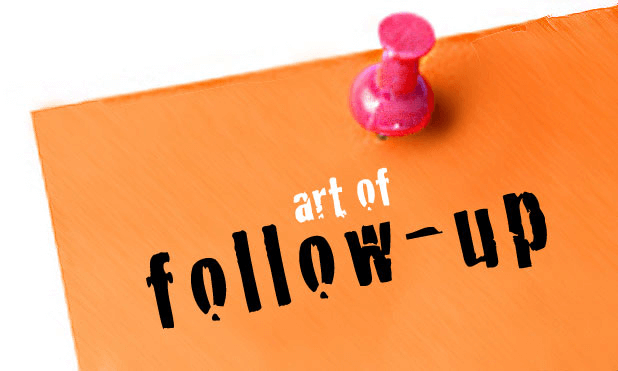
People do business with people, not documents. That’s why it’s important to follow up with your client in order to keep the relationship going.
Ideally, your business proposal will have impressed your client so much that they will contact you back immediately. Unfortunately, this is rare.
They will likely have several proposals to look through and this could take some time.
So even though it’s hard, try not to jump down their throats too soon after you submit.
Once you’ve given them some time, drop them an email or give them a quick call.
Make sure they know that you’re available to answer any questions they may have about your proposal.
If you have submitted digitally and you have document analytics or email tracking software in place, then you’ll know when your proposal has been seen and you can time your follow up accordingly.
Business proposal templates
There are lots of companies that offer free business proposal software and templates. Some of them are terrible.
So, I’ve weeded those out and compiled a shortlist list of the 3 very best options.
Let’s take a look at them.
Proposify
This is by far my favourite resource for a free business proposal template.
They currently have more than 70 free proposals to choose from, ranging from accounting advertising and architecture, to web design and wordpress development.
Their business proposals are well-written, well-designed and completely customisable.
They also seem to be adding new ones daily.
The proposals are organised into 6 main categories:
- Design.
- Software.
- Marketing.
- Events.
- Real estate.
- Professional services.
Let’s take a closer look at some of Proposify’s best business proposal templates.
Free template number 1
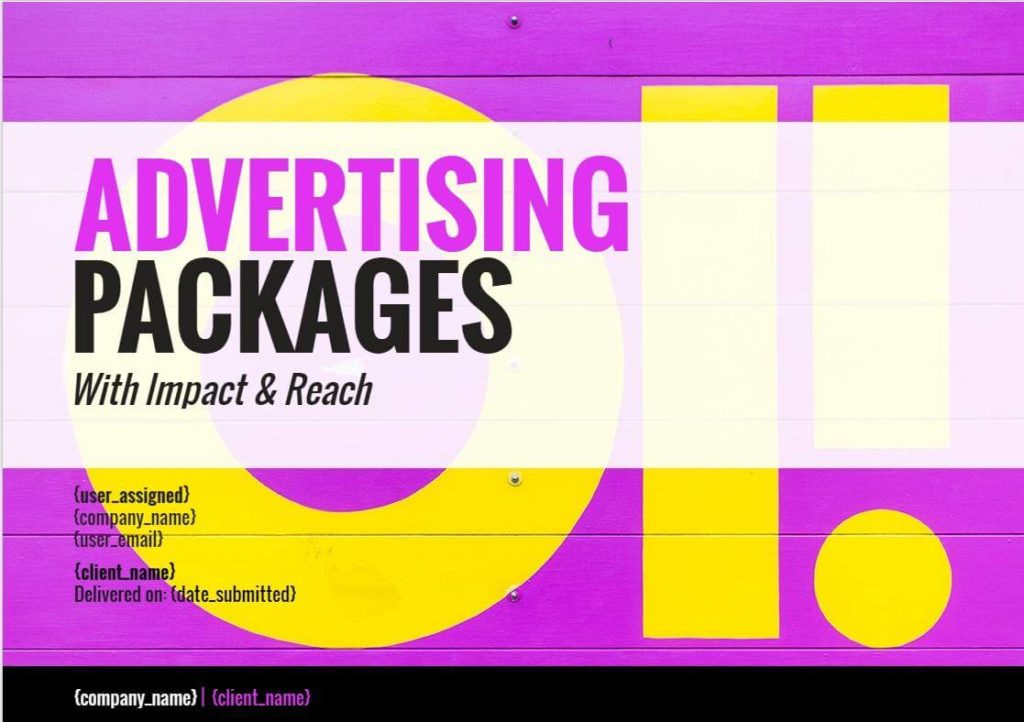
Proposify’s advertising proposal template.
This one is 11 pages long and has some great eye-catching designs which are perfect for those in the advertising industry where it’s all about grabbing people’s attention.
This is a great example of how well thought out the designs are on the Proposify options. Not only is this proposal well-designed, but it also suits the industry that it’s aiming for.
Sadly, not many companies put this much thought into the look and design of their proposals.
But, as we’ve already learnt in the cover page section, design is a crucial element of your business proposal. So this one gets two thumbs up!
Free template number 2
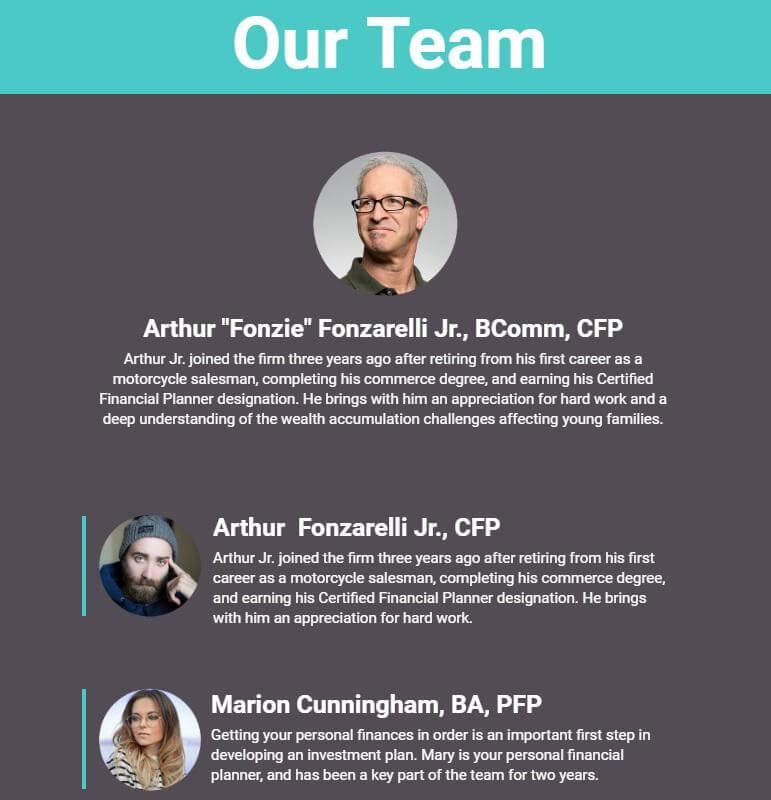
Proposify investment proposal template.
This is a page from inside the investment business proposal template. I like how the colour scheme reflects the serious nature of the finance industry but also adds a little fun design element.
Free template number 3
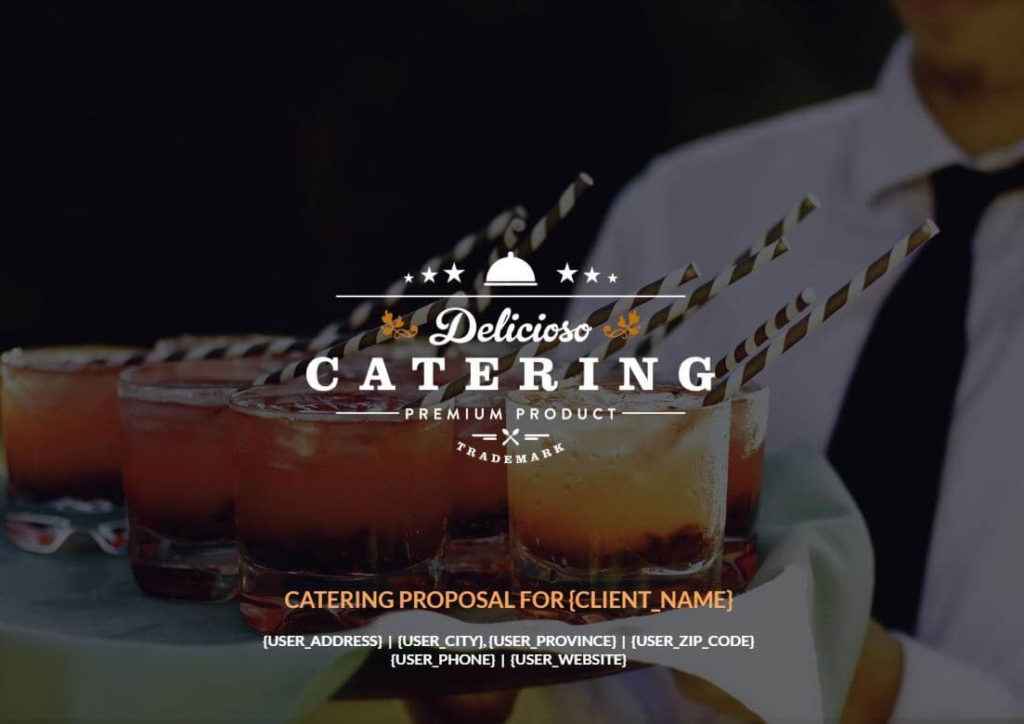
This 12 page business proposal template would be great for anyone in the food business. It has an introduction and about page, and options to showcase themes and previous work:

Proposify catering proposal template
Free template number 4
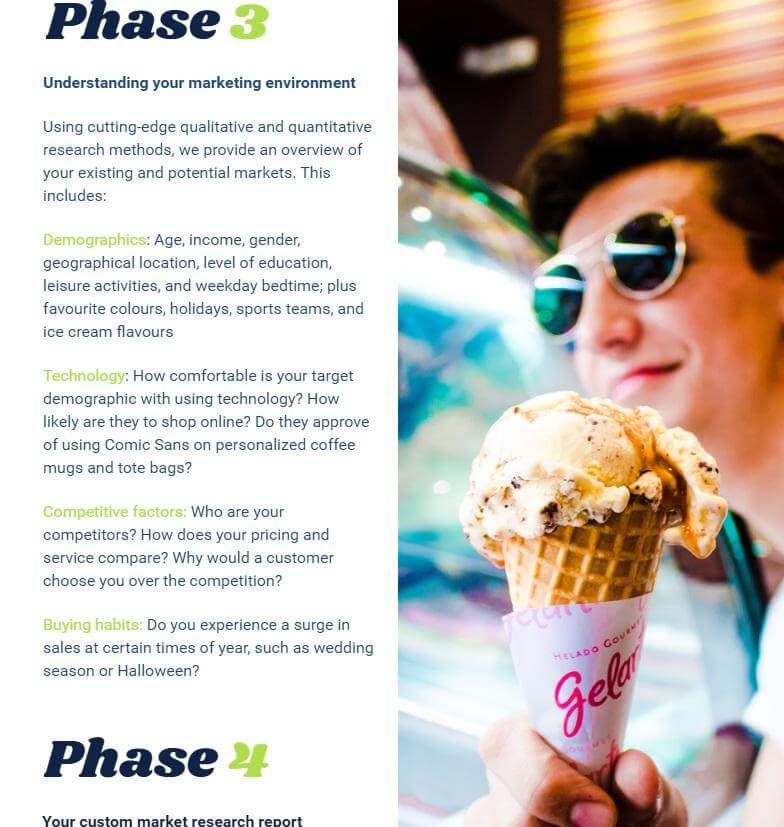
Proposify market research template
This 10 page offering for those in the marketing game is funky, fun and full of energy.
There’s plenty of space to explain the phases of your project and your overall methodology. There are also pages for introducing your team and including client testimonials.
Free template number 5
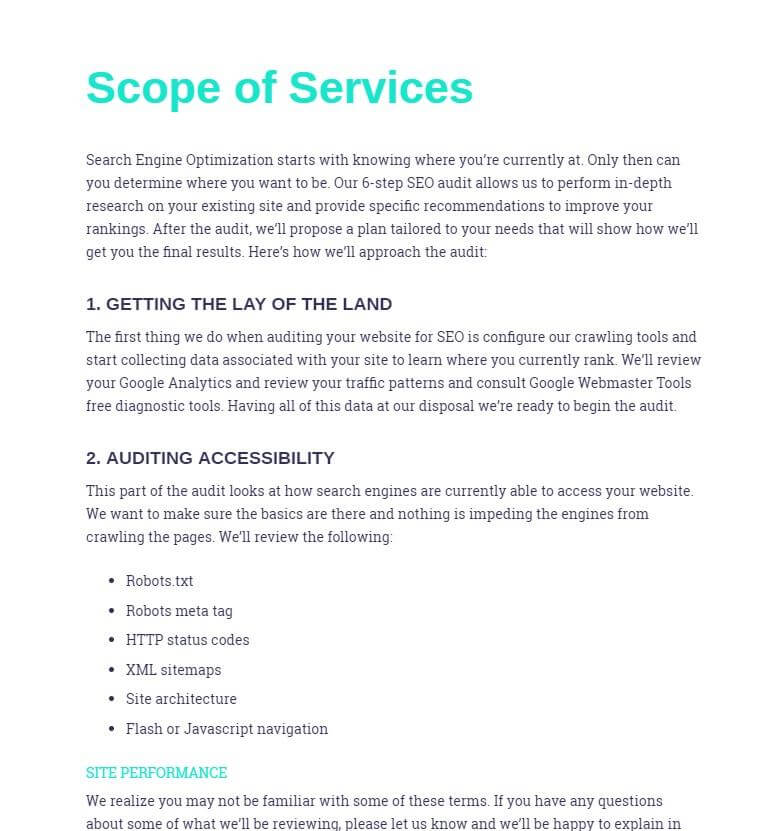
Proposify’s SEO proposal template.
Suitable for marketing agencies and freelancers, this 16 page business proposal template is chocked full of information that could save you a ton of time writing. The statement of work and contract at the end is also extensive.
Qwilr
Qwilr has some good modern designs.
There aren’t a huge range of business proposal examples to choose from (Less than 20 by my count), but the ones they do have are very good.
It’s quick and easy to knock one up and the proposals look clean and feel pretty slick.
If you use Qwlir, you can also set up notifications that tell you when your proposal has been viewed.
My only gripe with them is that you can’t easily separate the business proposals from the other documents they offer, which means it takes longer to find what you’re looking for.
I guess they just don’t have enough business proposals to warrant making an extra section for them on the website.
The best way to find them is to look through everything on the popular page. There is an option to select “business” but I found that when I did this, some of the proposals didn’t show up.
Despite the dodgy organisation, it’s well worth checking them out.
Here’s my top picks from Qwilr:
Free template number 6
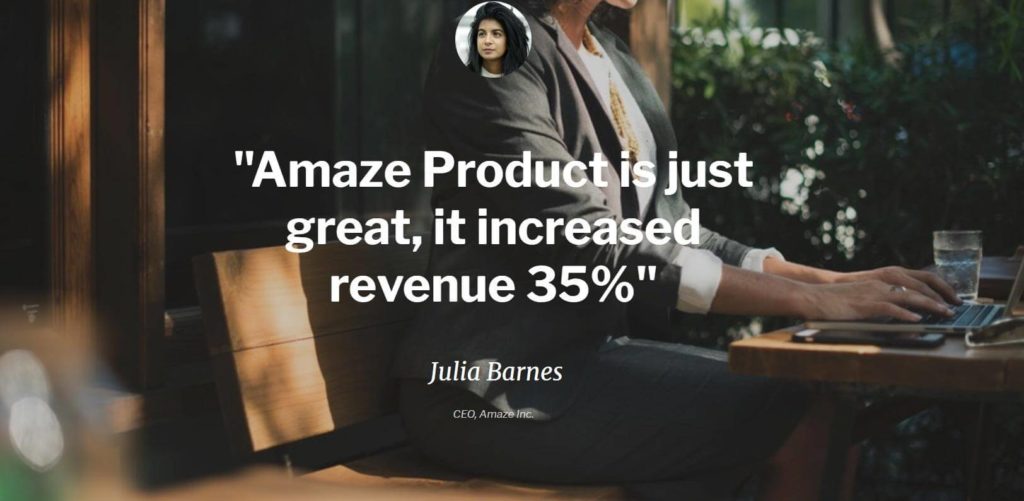
Qwilr’s sales proposal template.
Video is so hot right now, which is why it’s great that you can easily incorporate video into this sales template. You can embed spreadsheets and slideshare presentations too.
On the whole, it’s very professional looking and feels current. I imagine that this would be a difficult one to say no to.
Free template number 7
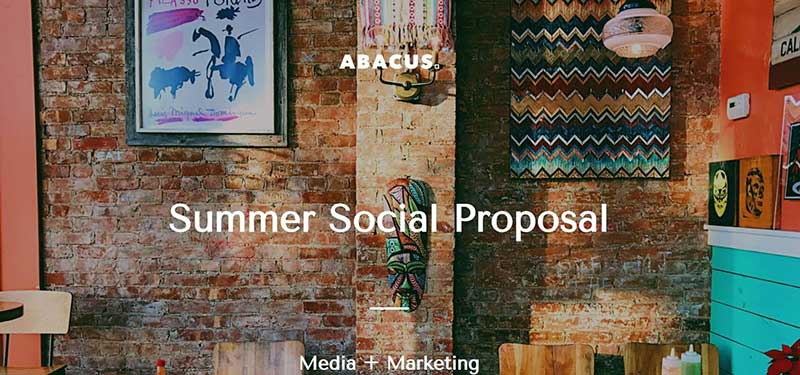
Qwilr’s Marketing agency proposal
Those in the marketing biz will love this well-designed offering. This marketing agency proposal ticks all the boxes.
The design on this one somehow makes everything seem simpler and less overwhelming.
The images are great and text is good enough to base your ideas around (with just a few tweaks to customise).
Free template number 8
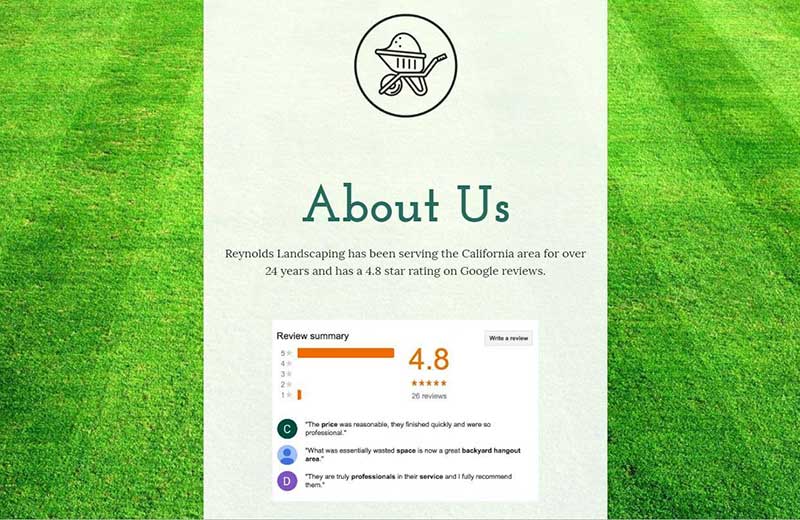
Qwilr’s Landscaping proposal template.
How nice does that lawn look?
The review summary in this vibrant landscaping proposal template is a nice touch and a good example of how you can include social proof.
As you would expect, there’s plenty of space in here to show off your proposed designs as well as previous work.
As this is a visual industry, this template contains more images than most. But there’s also room to go through the various services you offer and explain your pricing.
Free template number 9
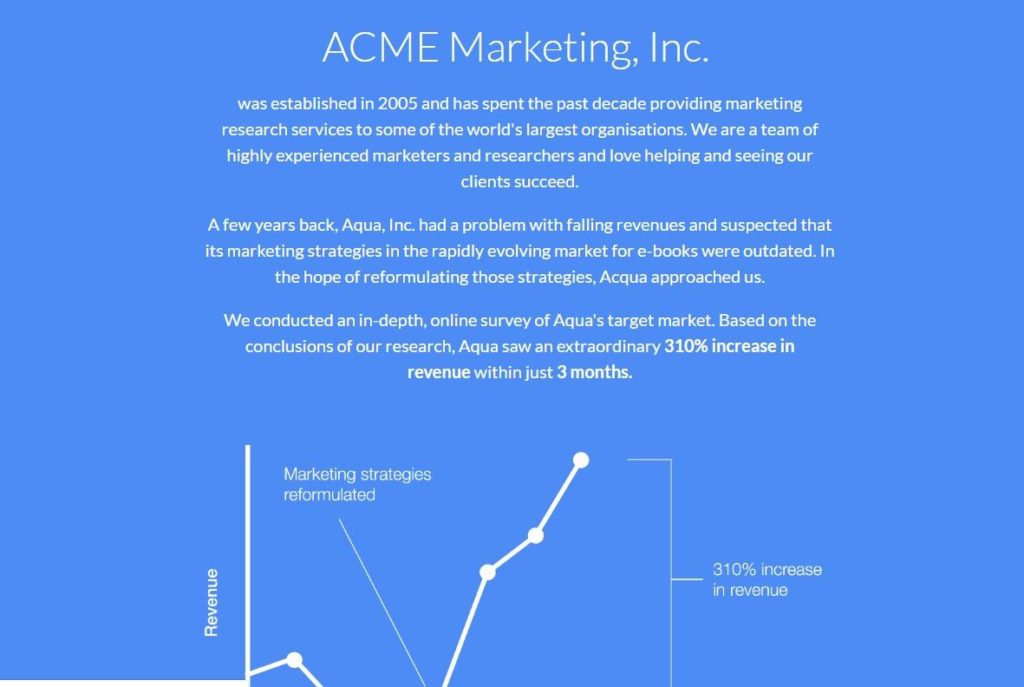
Qwilr’s Advertising proposal template.
If you’re pitching your advertising skills, you might want to use this bold and simple template that focuses on results.
It’s clean, professional and the imagery is minimal, meaning there’s no distractions from the bottom line.
Free template number 10
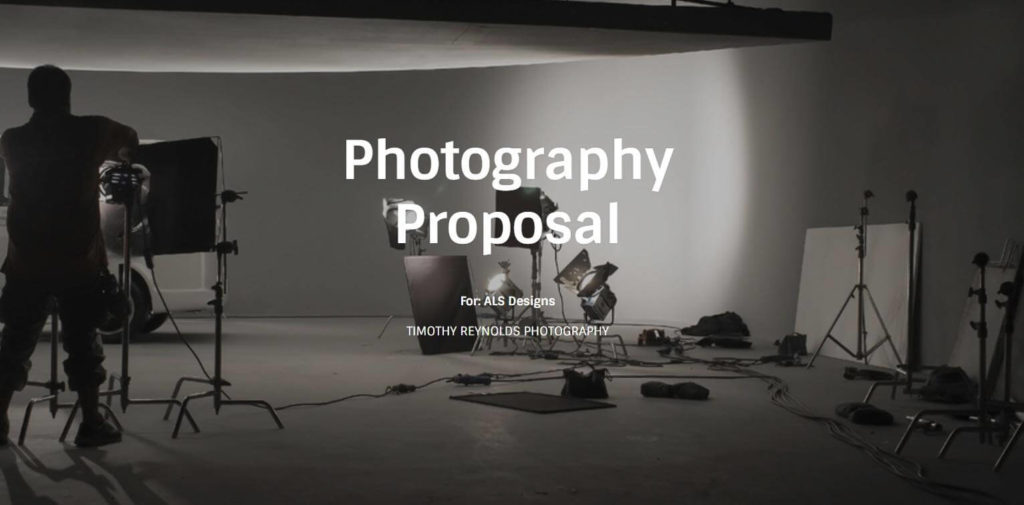
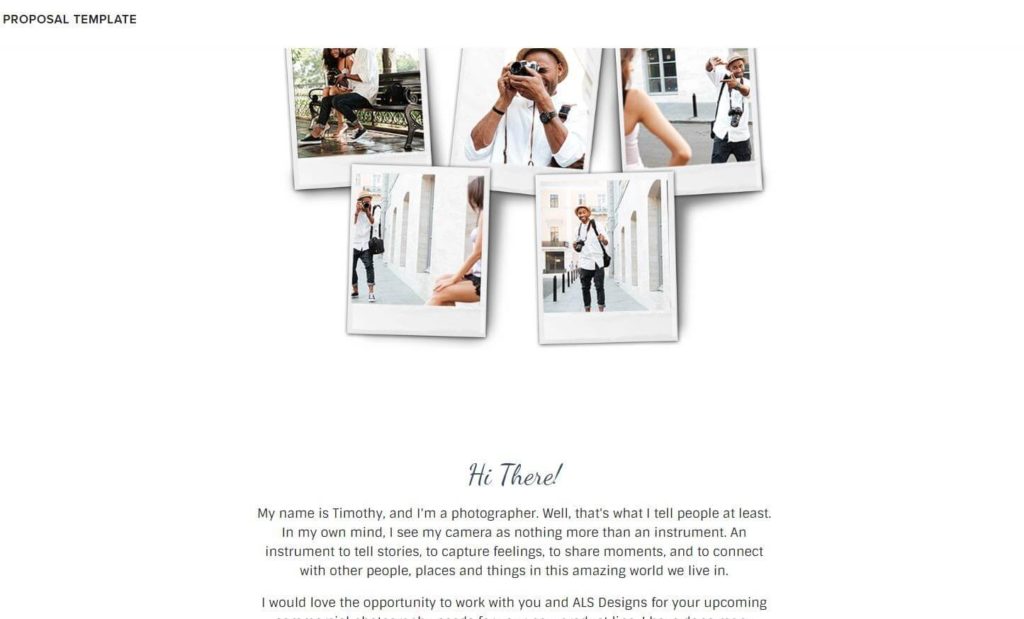
Qwlr’s Photography proposal template.
This is a great format for freelance photographers. The tone is relaxed and the overall proposal comes across as friendly and inviting, which is exactly what you want if you’re looking to get booked for weddings and events.
PandaDoc
PandaDoc has over 450 templates available. But, it’s not as easy to browse through them as it is with Proposify and the Designs aren’t quite as good as either Proposfy or Qwilr, which is why it gets the number 3 spot.
Free template number 11
This is a pricing page taken from PandaDoc’s copywriting template. It has a contents page, room for an introduction and includes an executive summary, testimonials and terms and conditions.
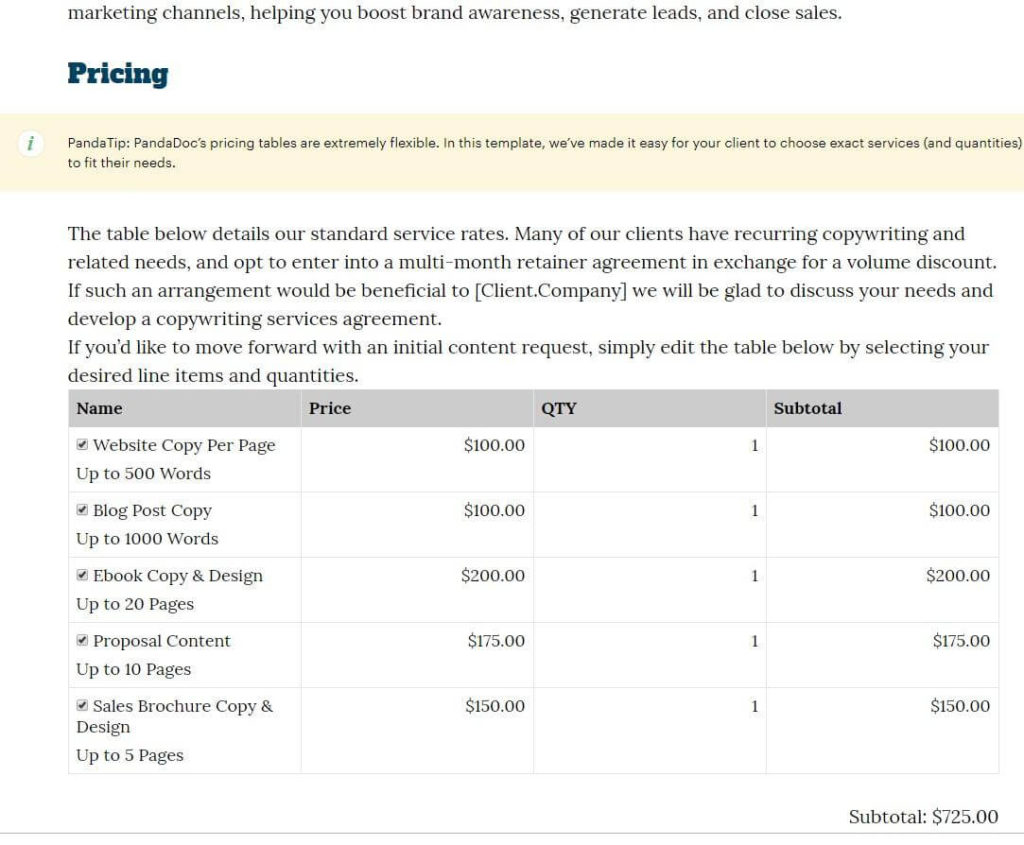
PandaDoc’s copywriting proposal template.
Their proposals are comprehensive and very professional looking.
The design element is somewhat lacking compared to Proposify however, and you’ll find that the same design is used again for different Industries:
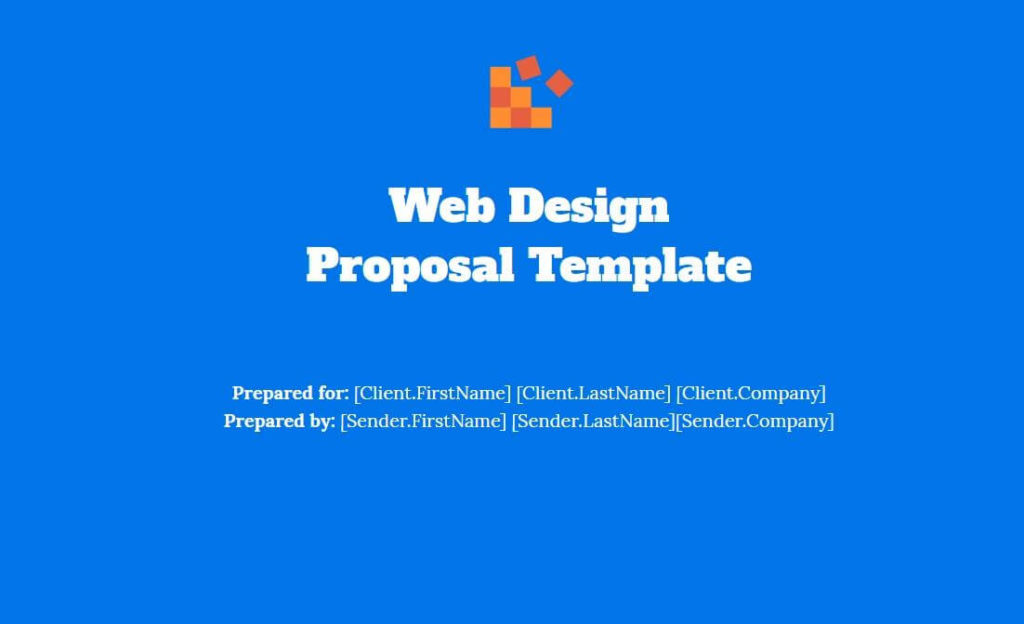
PandaDoc’s web design proposal template.
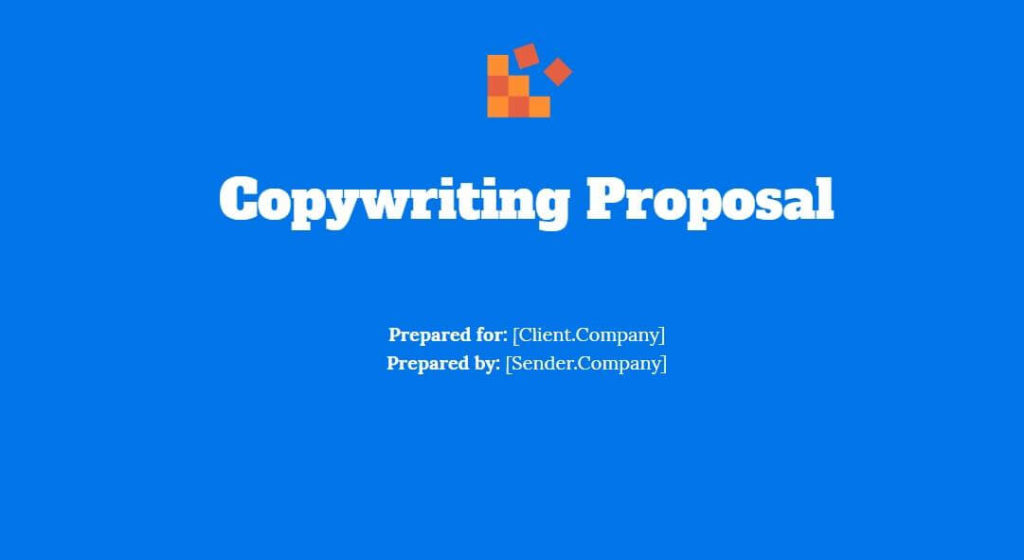
PandaDoc’s copywriting proposal template.
Free template number 12
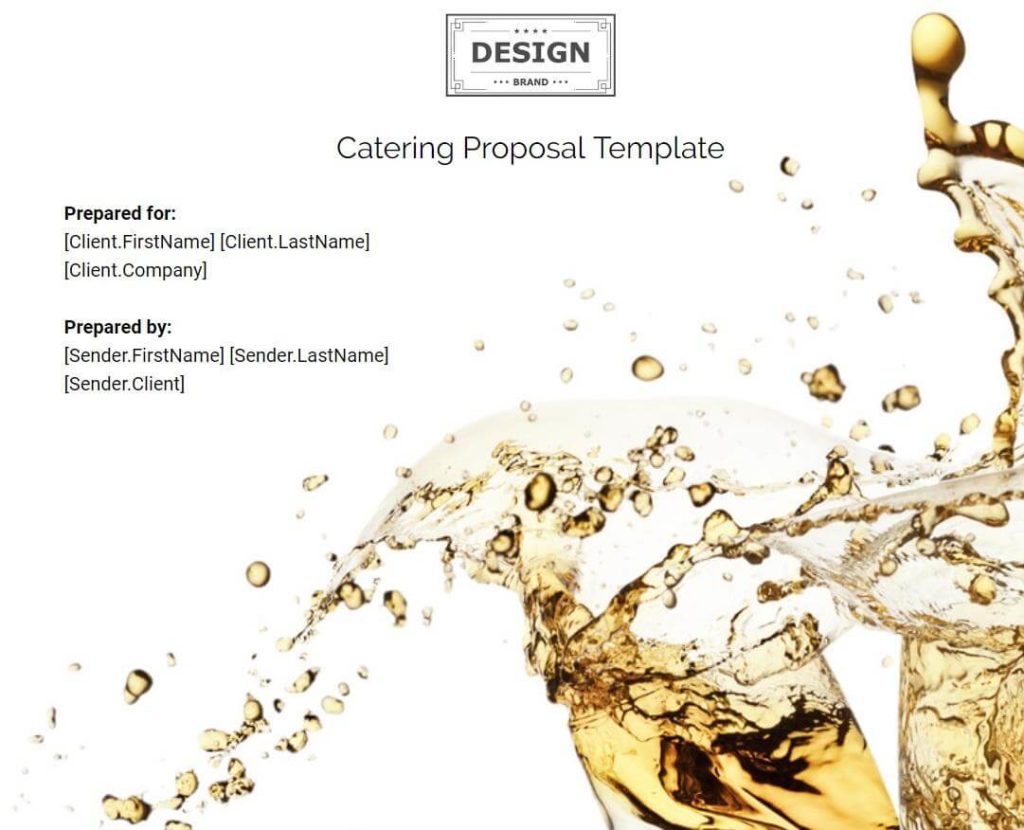
PandaDoc’s catering proposal template.
The catering proposal will get the job done. It has a nice design and contains lots of useful hints and tips.
There’s a handy table for keeping track of all the equipment needed, a place to break down the menu and to detail staffing and decoration requirements.
Free template number 13
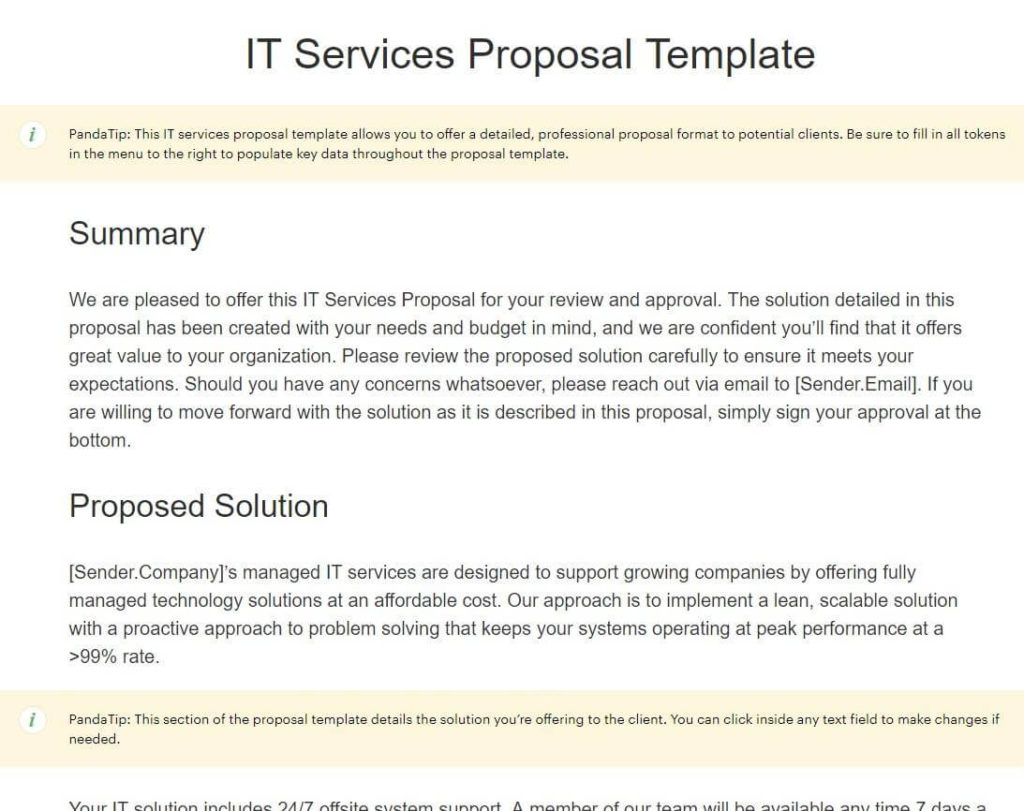
PandaDoc’s IT Services proposal template.
This IT services proposal template is great for those who want to keep it short and sweet. There’s options to add images,video and pricing tables (although this may incur charges).
Free template number 14
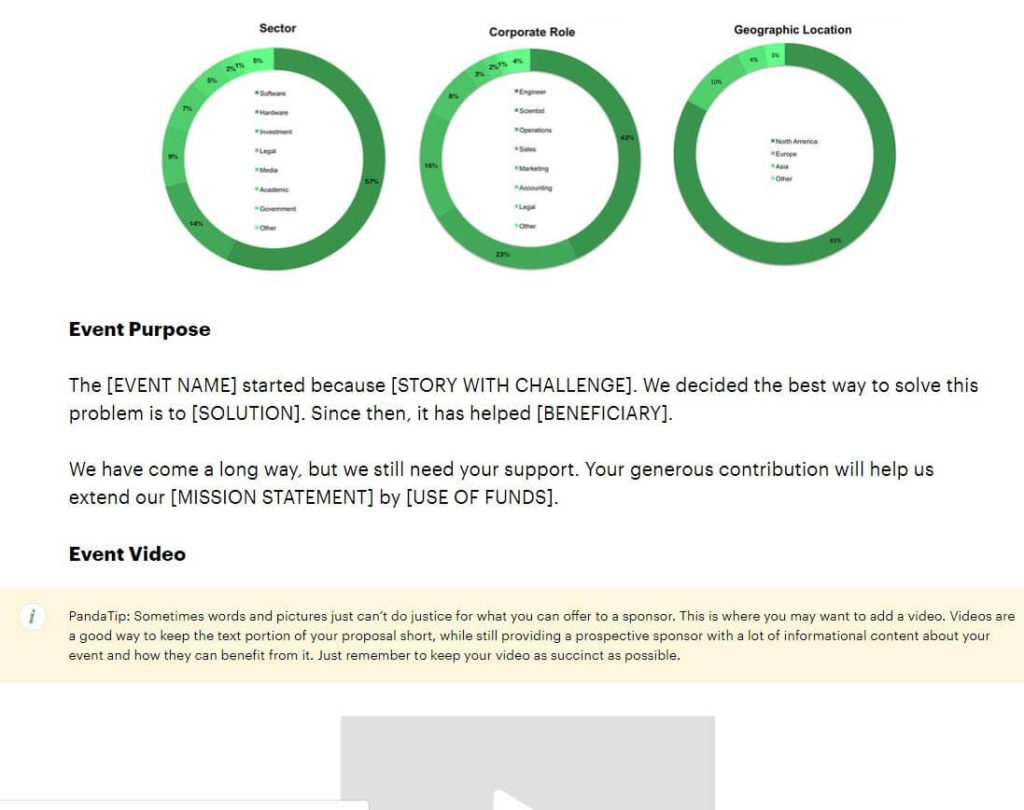
PandaDocs sponsorship proposal template.
If you’re looking to pitch a sponsorship deal for an event, look no further than this template.
As with all of PandaDoc’s templates, It’s fully customisable, allowing you to add video and organise information in a way that works for you and appeals visually.
Free template number 15
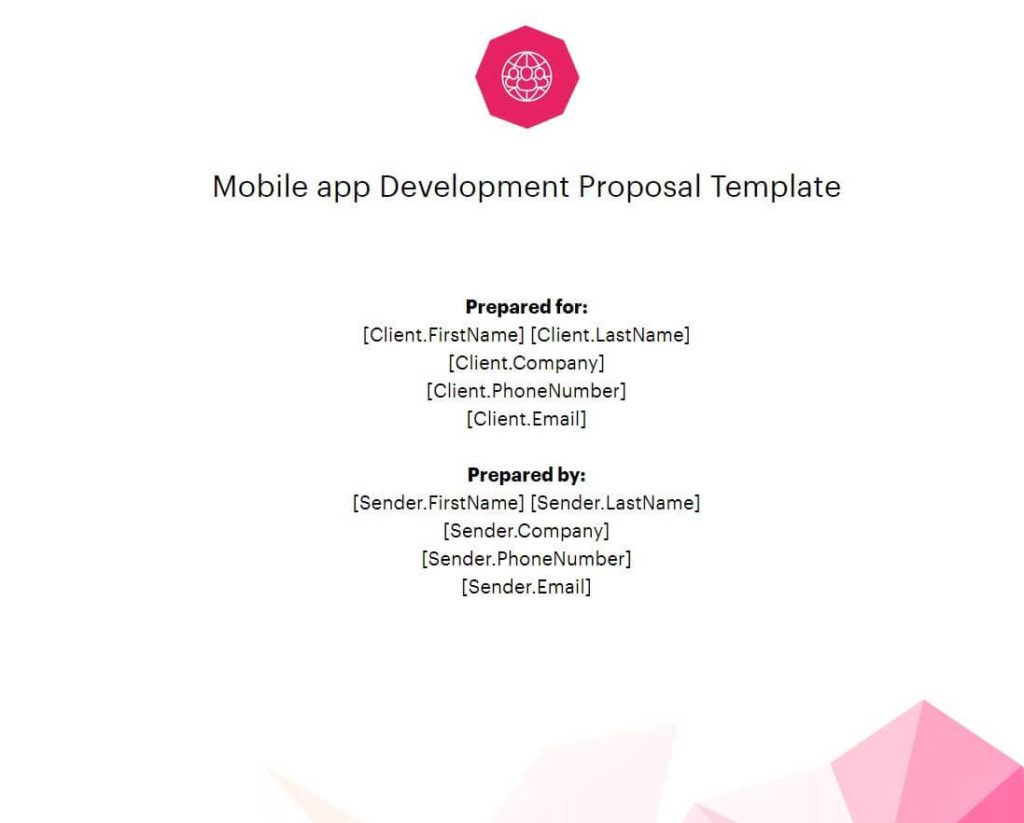
PandaDoc’s Mobile app development proposal.
If you’re a budding app creator, this one could be ideal for you. This proposal has a nice simple design and contains plenty of useful information that provides a great framework for putting together a well thought out proposal aimed at the mobile app industry.
Decktopus
Decktopus is a new generation business proposal template creation tool that allows users to create good-looking, and living documents in no time.
The tool consists of more than 100 templates that are ready to use. All you need to bring is your content!
Decktopus allows you to share your business proposal template live, or you can also choose to embed the presentation on your website.
The greatest feature of Decktopus is that you can easily connect with your clients or leads through the interactive forms that you can add to your business proposal template.
So, you can easily close the deal within the presentation with Decktopus!
Decktopus has over 100,000 users worldwide. Decktopus is climbing the stairs in becoming the fastest and most engaging business proposal & presentation creation tool for no-code creators and busy professionals or anyone who wants to share their know-how!
Let’s wrap this up
There you have it. If you have listened well, you should now have all the information you need to write an effective business proposal and follow up with potential customers.
So, what are you waiting for?
Scroll back up to the top and let’s get cracking!
Best of luck, I hope you nail it!
Read more: top 19 Venngage consultant business templates you could use right away.

Last Updated on March 28, 2024 by Ian Naylor
One thought on “How to Write a Business Proposal in 2021: 6 Steps + 15 Free Templates”